Protein Expression and Purification
Optimizing Protein Expression Systems for Structural and Functional Studies
Fast Protein Liquid Chromatography
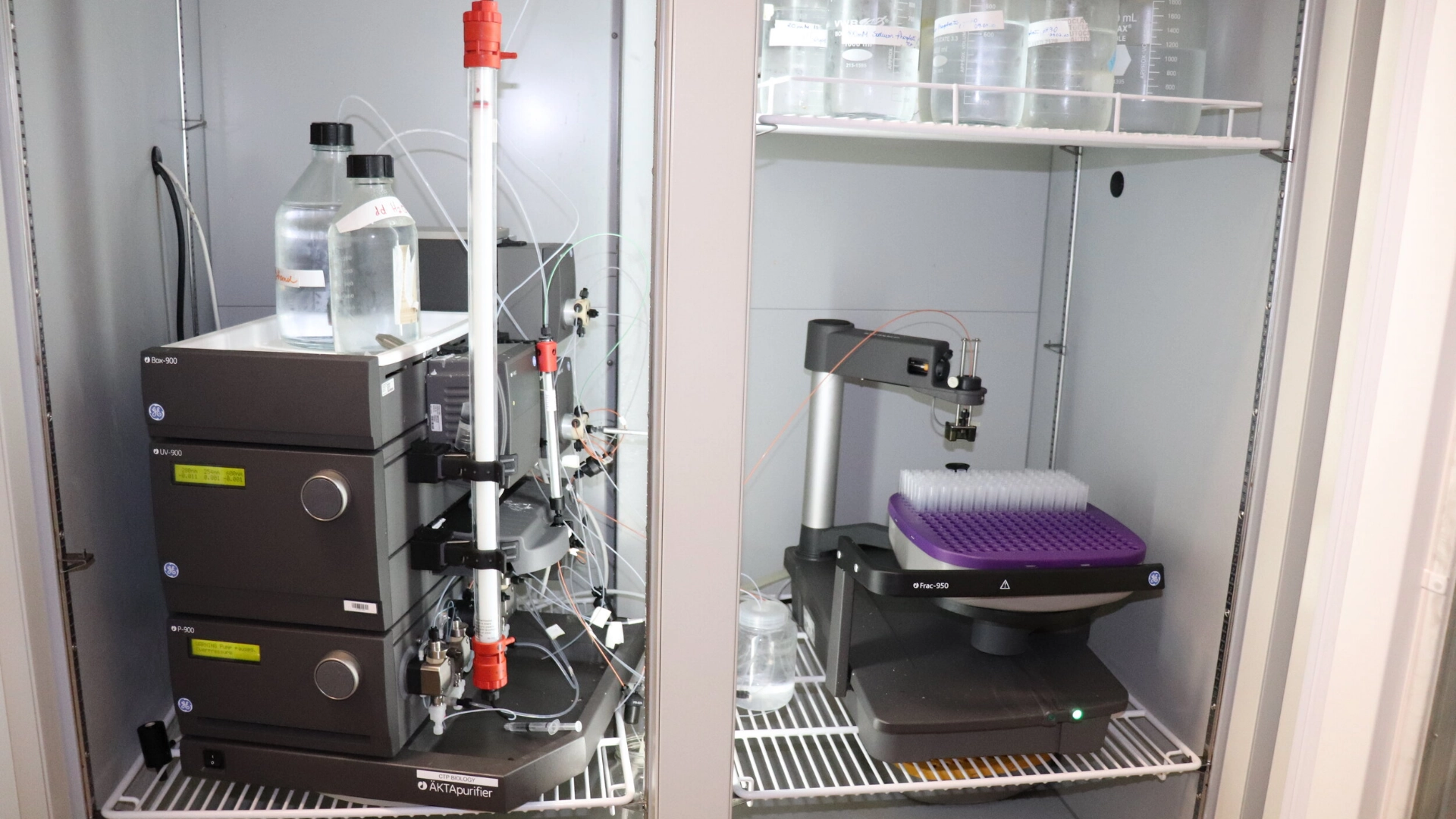
The ÄKTA Explorer 100 Air is a high-performance liquid chromatography system. It is designed for the purification and analysis of biomolecules, such as proteins, peptides, nucleic acids, and other biomacromolecules. It is equipped with advanced features for controlling flow rates, pressures, and gradients, ensuring precise separation and purification of biomolecules.
Key Features
High Flexibility:
- Accommodates a wide range of chromatography techniques, including ion exchange, size exclusion, affinity, and hydrophobic interaction chromatography.
Advanced Control:
- Uses the UNICORN software for method development, system control, and data analysis.
- Offers precise gradient formation and flow control for reproducible results.
Air-Supported System:
- The “Air” designation indicates its capability to handle air as a displacement medium for liquid delivery, reducing contamination risks and ensuring accurate gradient formation.
Wide Flow Rate Range:
- Suitable for both small-scale and preparative-scale applications, with flow rates ranging from microliters to hundreds of milliliters per minute.
High Sensitivity Detection:
- Equipped with UV/Vis detectors for real-time monitoring of sample components.
Scalability:
- Allows easy transfer of methods from small-scale to large-scale production.
Integrated Fraction Collector:
- Automated fraction collection based on user-defined criteria, such as UV absorbance or time.
Applications
Protein Purification:
- Isolation of recombinant proteins, monoclonal antibodies, and native proteins.
- High-resolution separation for structural and functional studies.
Nucleic Acid Purification:
- Purification of DNA, RNA, and plasmids for downstream applications like sequencing or gene therapy.
Process Development:
- Optimization of purification processes for biopharmaceutical production.
Biomolecule Characterization:
- Analysis of molecular weight, charge, and hydrophobicity.
Quality Control:
- Ensuring the purity and consistency of biomolecules in research and production.
Drug Discovery and Development:
- Purification of drug candidates, including peptides and small molecules.
Gel Imaging System
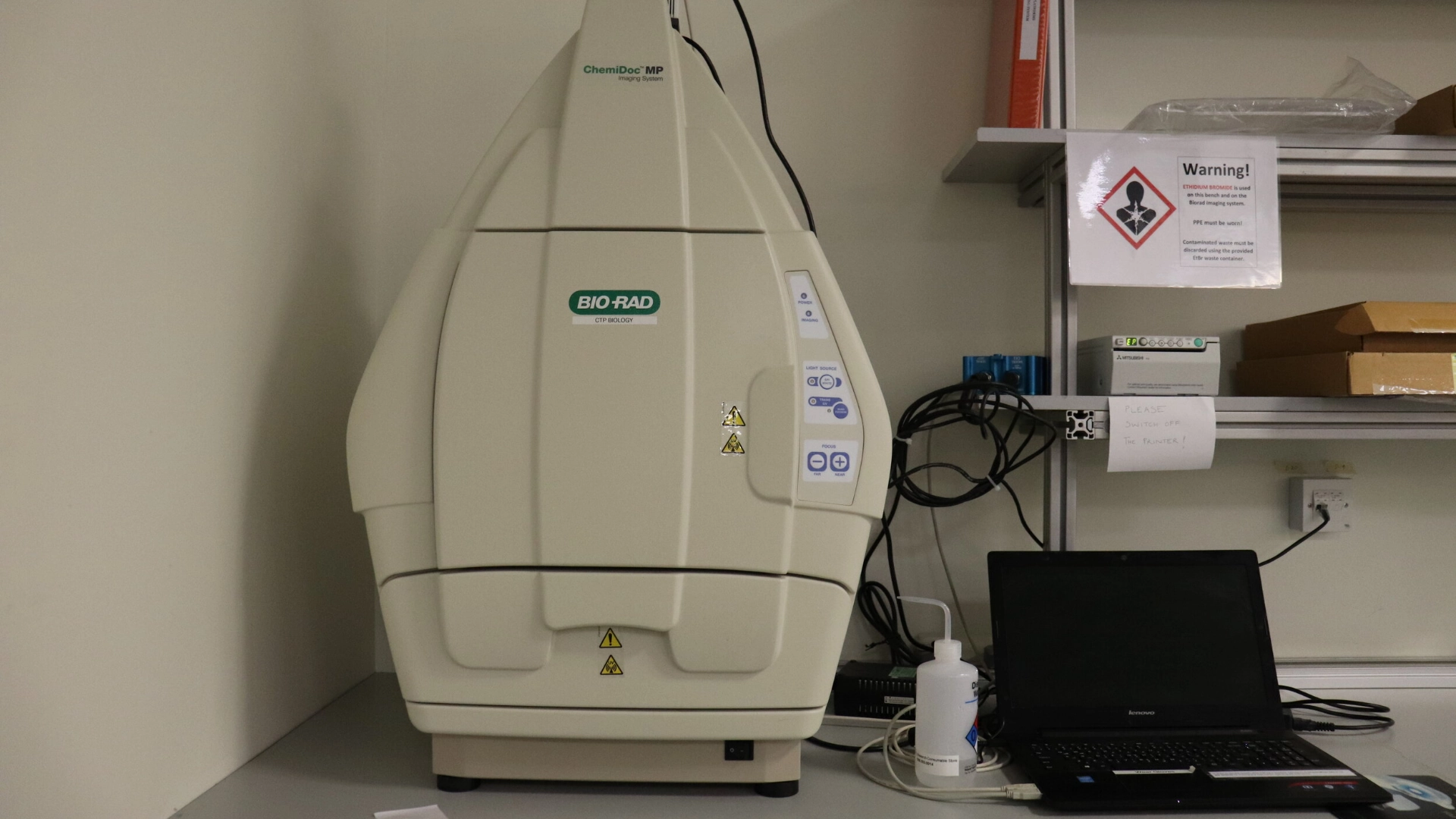
The ChemiDoc XRS+ System is a high-performance imaging platform that utilizes a CCD (charge-coupled device) camera to capture high-resolution images of samples. It is optimized for detecting chemiluminescence, fluorescence, and colorimetric signals, making it a valuable tool for researchers performing Western blots, nucleic acid analysis, and protein quantification.
Key Features
High Sensitivity and Resolution:
- Equipped with a highly sensitive CCD camera for detecting low-intensity signals.
- Provides high-resolution images for detailed analysis.
Multi-Application Support:
- Compatible with chemiluminescent, fluorescent, and colorimetric detection methods.
- Supports a wide range of dyes and stains.
Ease of Use:
- Intuitive software for image acquisition, analysis, and reporting.
- Automated settings for exposure, focus, and image optimization.
Dynamic Range:
- Broad dynamic range for accurate quantification of both strong and weak signals in the same image.
Advanced Imaging Modes:
- Chemiluminescence: High sensitivity for Western blot detection.
- Fluorescence: Multiple excitation and emission filter options.
- Colorimetric: Ideal for visible stains like Coomassie Blue or silver staining.
Modular Design:
- Can be customized with various filters and accessories to meet specific research needs.
Integrated Analysis Tools:
- Provides tools for densitometry, molecular weight estimation, and quantitative analysis.
Compatibility:
- Works seamlessly with Bio-Rad’s reagents and gels, such as the Stain-Free technology for protein detection.
Applications
Western Blot Analysis:
- Detection of proteins using chemiluminescence or fluorescence.
Gel Documentation:
- Imaging of nucleic acid gels stained with ethidium bromide or SYBR dyes.
- Protein gels stained with Coomassie or silver stain.
Quantitative Analysis:
- Quantification of protein or nucleic acid concentrations.
Multiplex Fluorescence Imaging:
- Detection of multiple targets in a single experiment using different fluorescent dyes.
Molecular Weight Determination:
- Estimation of molecular weights based on ladder standards.
Stain-Free Technology:
- Direct visualization of proteins without the need for staining, reducing processing time.
DNA/RNA Analysis:
- Imaging of agarose gels for electrophoresis results.
LEX Bioreactor
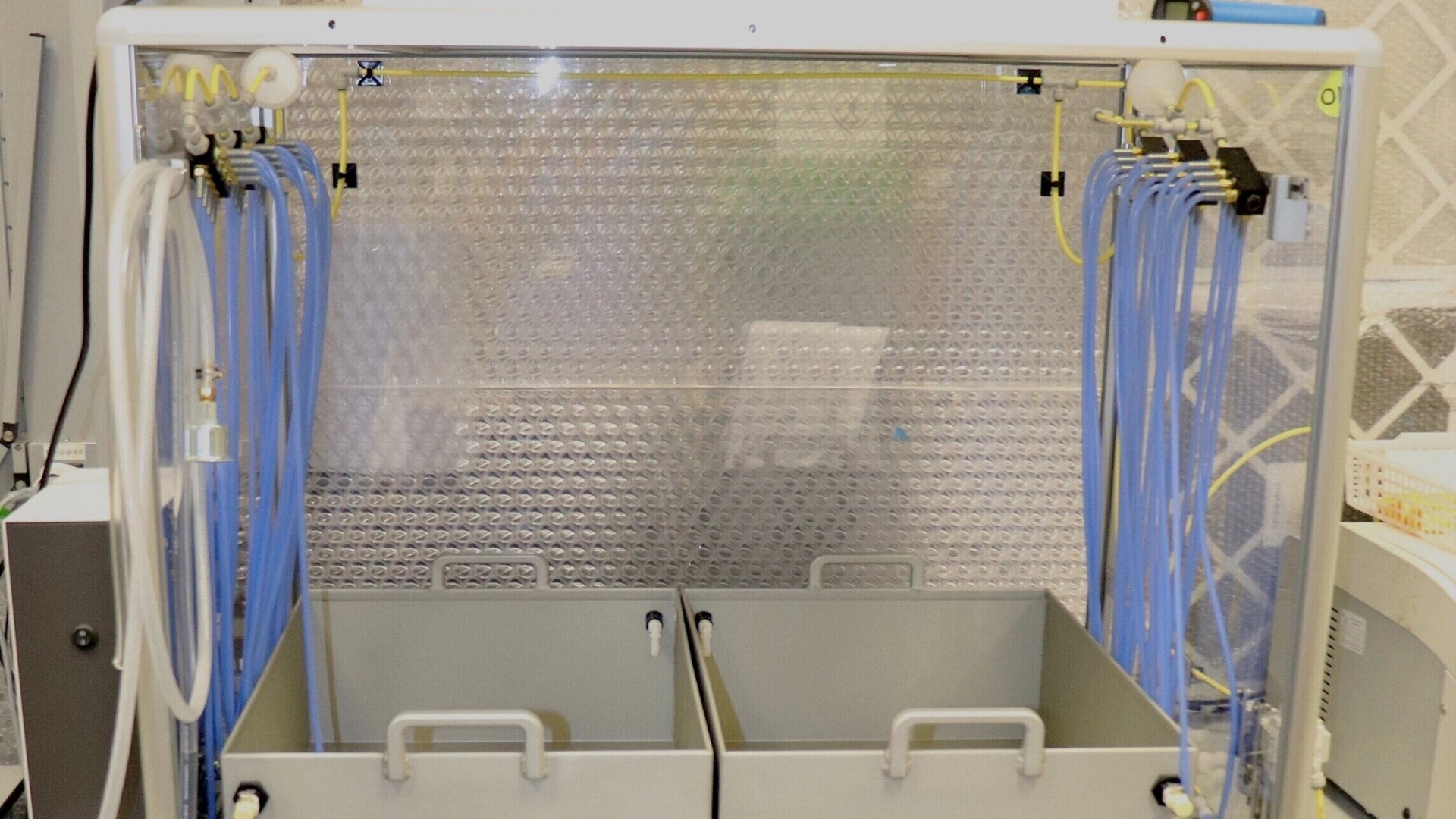
The LEX bioreactor is a large-scale expression system used for the efficient production of recombinant proteins. It is particularly suited for structural biology applications, such as X-ray crystallography and cryo-electron microscopy, which require high yields of high-quality proteins. The technology is designed to be cost-effective, scalable, and user-friendly, enabling researchers to produce proteins in sufficient quantities for downstream applications.
Key Features
Scalability:
- Supports large-volume cultures, typically in the range of liters, making it ideal for producing proteins in significant quantities.
High Yield:
- Optimized for maximizing protein expression, especially in bacterial systems like Escherichia coli.
Cost-Effectiveness:
- Uses standard laboratory equipment and consumables, reducing operational costs compared to more complex bioreactors.
Ease of Use:
- Simple setup and operation, allowing researchers without extensive bioreactor experience to use the system effectively.
Controlled Environment:
- Provides precise control over growth conditions, including temperature, aeration, and nutrient availability, to optimize protein production.
Adaptability:
- Can be used with a variety of host organisms and expression systems, although it is most commonly employed with bacterial hosts.
Applications
Structural Biology:
- Producing large quantities of proteins for X-ray crystallography and cryo-EM studies to determine protein structures.
Drug Discovery:
- Generating proteins for high-throughput screening of potential drug candidates.
Functional Studies:
- Producing enzymes, receptors, and other proteins for biochemical and biophysical assays.
Protein Engineering:
- Supporting efforts to design and test modified proteins with improved properties or novel functions.
Academic Research:
- Used in academic and non-profit research settings to study protein function, interactions, and mechanisms.
Biotechnology Development:
- Aiding in the production of enzymes and proteins for industrial or therapeutic applications.
Ultrasonic Liquid Processors
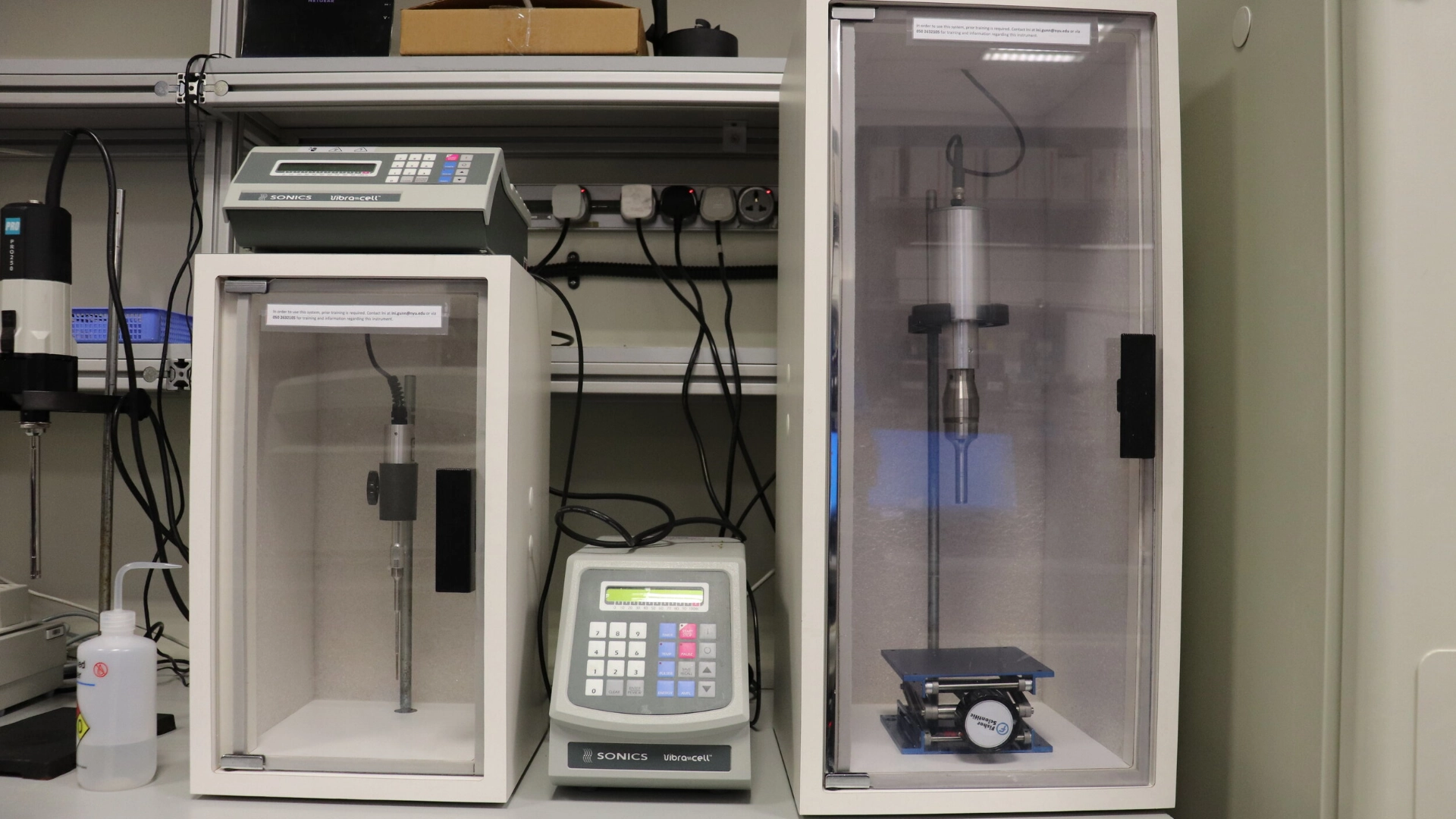
The VCX 130 and VCX 750 are ultrasonic homogenizers or sonicators that use ultrasonic energy to create cavitation in liquids. This cavitation generates intense shear forces that can break down particles, disrupt cells, or emulsify mixtures. The numbers (130 and 750) indicate the maximum power output in watts, with the VCX 130 providing up to 130 watts and the VCX 750 up to 750 watts.
Key Features
- Variable Power Output: Adjustable power levels to suit different applications.
- High-Performance Transducer: Converts electrical energy into mechanical vibrations for efficient cavitation.
- Digital Control Panel: Allows precise adjustment of parameters such as amplitude, pulse mode, and processing time.
- Pulse Mode: Alternates between on and off cycles to reduce heat generation during processing.
- Temperature Monitoring: Ensures samples are not overheated during operation.
- Interchangeable Probes: Compatible with various probe sizes for different volumes and applications.
- Compact Design: Suitable for benchtop use in laboratories.
- Safety Features: Overload protection and automatic shut-off.
Applications
- Biotechnology and Life Sciences:
- Cell disruption for DNA/RNA extraction.
- Protein solubilization.
- Preparation of nanoparticles.
- Pharmaceuticals:
- Emulsification for drug delivery systems.
- Dispersion of active ingredients.
- Chemical Processing:
- Homogenization of chemical mixtures.
- Acceleration of chemical reactions (sonochemistry).
- Food and Beverage:
- Emulsification of oils and water.
- Particle size reduction in beverages.
- Material Science:
- Nanoparticle dispersion.
- Breaking down agglomerates in suspensions.
- Environmental Science:
- Soil and water testing.
- Treatment of wastewater samples.
- Industrial Applications:
- Degassing liquids.
- Cleaning delicate components with cavitation.
Protein Columns
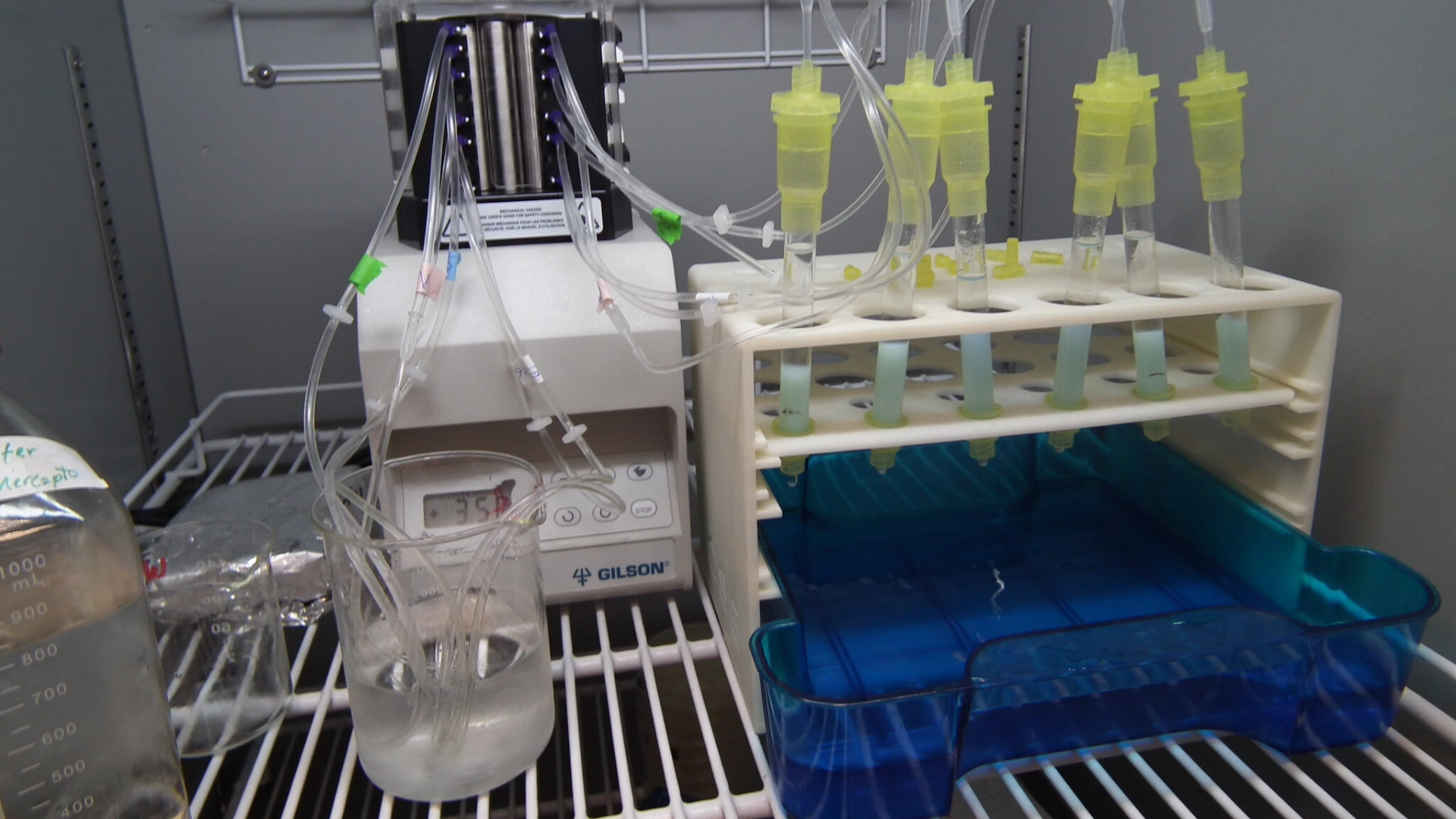
Protein Column Chromatography involves a chromatography column, which is a device used to separate proteins based on their physical and chemical properties. The column is typically a cylindrical tube packed with a stationary phase (e.g., resin or beads) through which a mobile phase (buffer solution) flows.
Key Features
Column Material:
- Made from glass, stainless steel, or plastic.
- Chemically inert and capable of withstanding high pressures for high-performance liquid chromatography (HPLC).
Stationary Phase:
- Packed with resin beads or a gel matrix.
- Types of stationary phases:
- Ion exchange resins (charge-based separation).
- Size-exclusion gels (size-based separation).
- Affinity resins (specific ligand-protein binding).
Flow System:
- Gravity flow or pump-driven flow for consistent pressure and flow rate.
- Adjustable flow rate for precise control over separation.
Detector Compatibility:
- Often coupled with UV-Vis spectrophotometers, fluorescence detectors, or mass spectrometers for protein detection and quantification.
Scalability:
- Available in sizes for analytical (small-scale) or preparative (large-scale) purposes.
Automation:
- Some systems include automated fraction collectors, gradient formers, and real-time monitoring.
Applications
Protein Purification:
- Isolation of specific proteins from complex mixtures, such as cell lysates or culture media.
Enzyme Isolation:
- Purification of enzymes for biochemical studies or industrial applications.
Antibody Purification:
- Affinity chromatography for monoclonal and polyclonal antibody isolation.
Biopharmaceutical Production:
- Purification of therapeutic proteins, peptides, and vaccines.
Proteomics Research:
- Analysis of protein interactions, structures, and functions.
Food and Beverage Industry:
- Separation and analysis of proteins in food products for quality control.
Environmental Analysis:
- Detection and quantification of proteins in environmental samples.
High-Speed Centrifuges
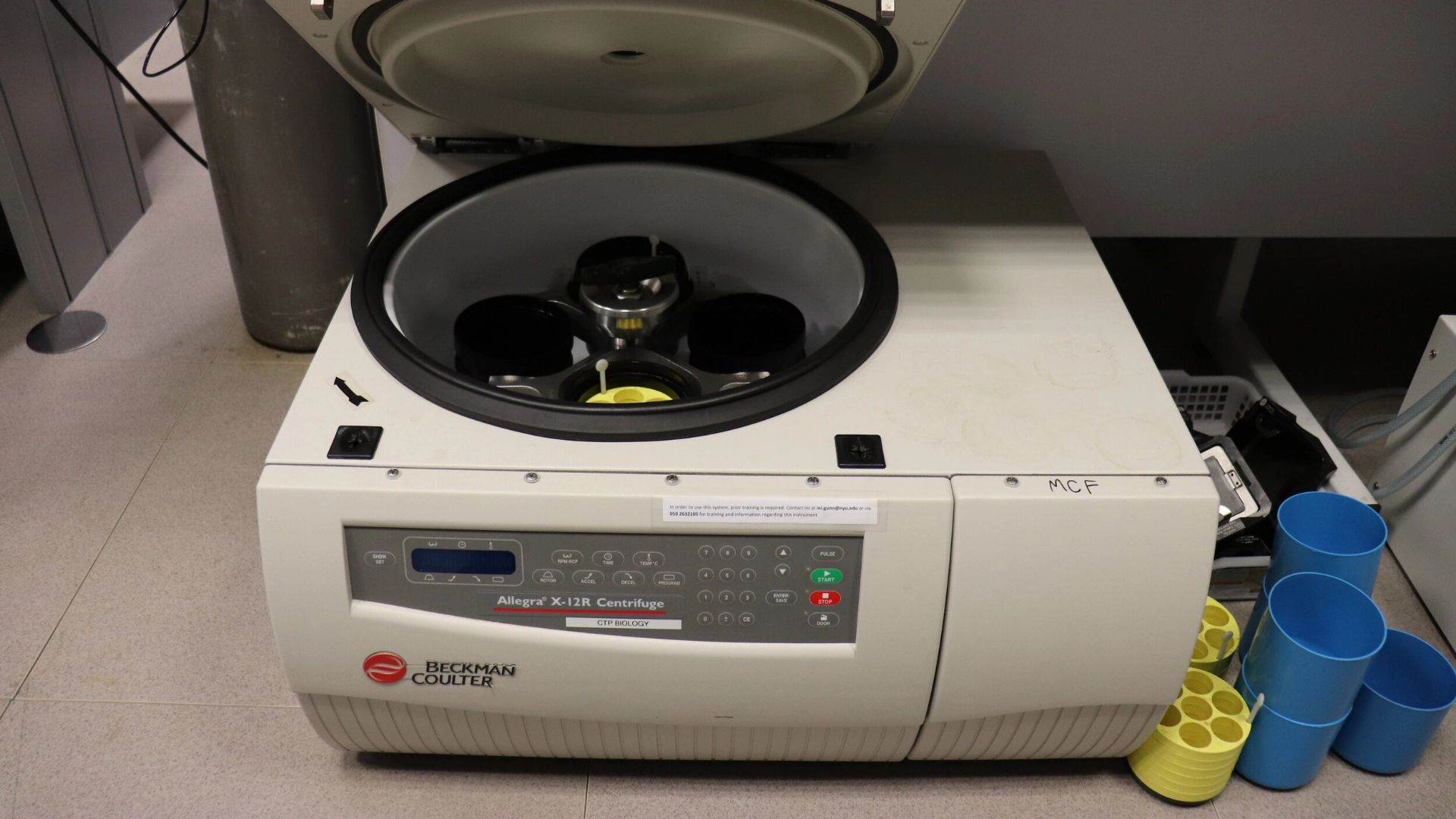
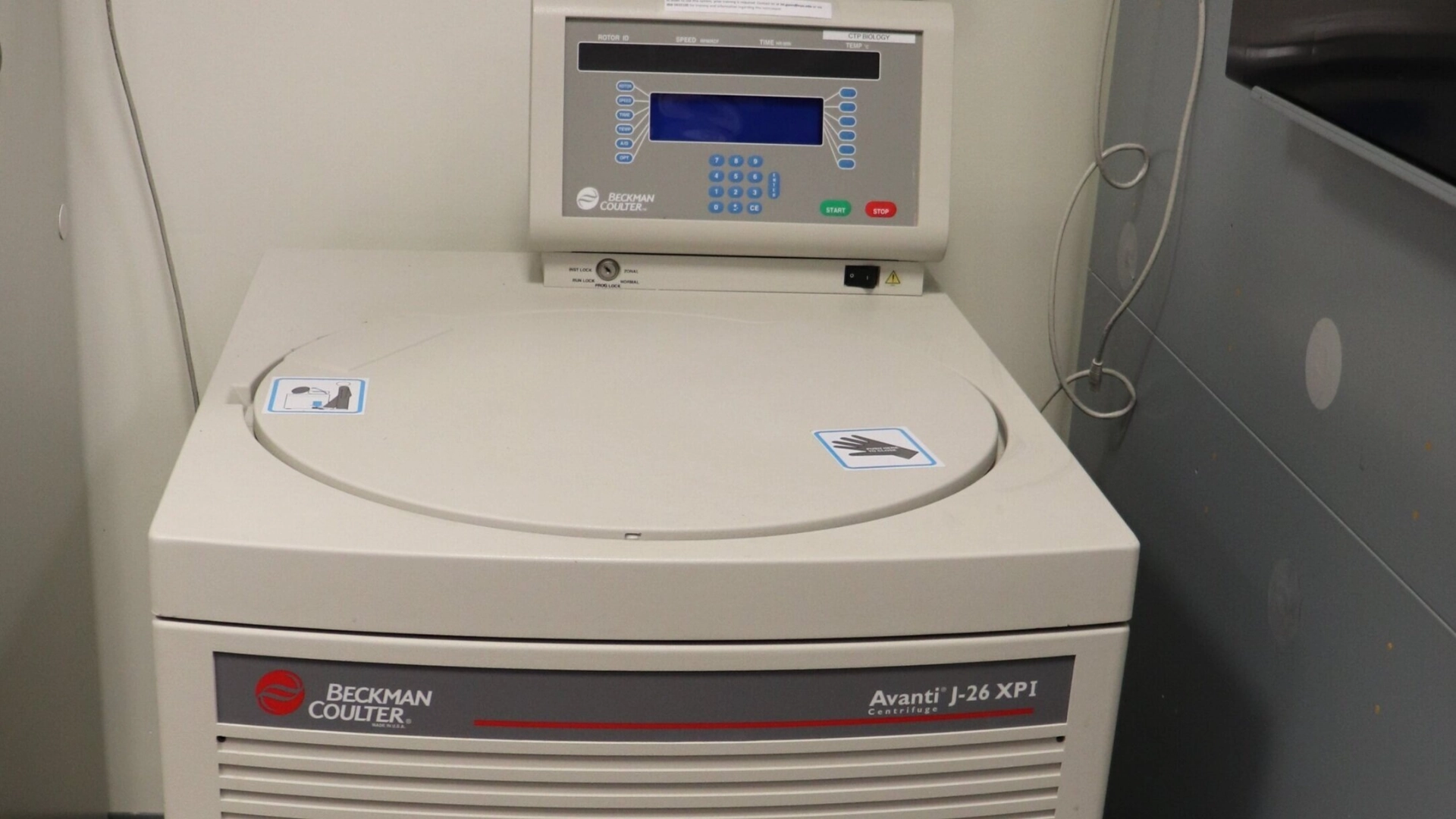
Allegra X-12R and Avanti J-26 XPI Centrifuges are high-performance laboratory centrifuges manufactured by Beckman Coulter, designed for a wide range of applications in research, clinical, and industrial settings. They are used to separate substances of different densities in a sample by applying centrifugal force.
Key Features
Allegra X-12R Centrifuge:
- Refrigerated Operation: Ensures temperature-sensitive samples remain stable during centrifugation.
- Compact Design: Saves valuable lab space.
- High Capacity: Accommodates a variety of rotors and adapters for diverse sample types.
- Ease of Use: Intuitive controls and digital display for easy operation.
- Speed Range: Capable of high speeds for efficient separation.
Avanti J-26 XPI Centrifuge:
- High Speed and Capacity: Delivers speeds up to 26,000 RPM and supports large sample volumes.
- Energy Efficiency: Equipped with an Eco-friendly system to minimize power consumption.
- Advanced Safety Features: Automatic rotor recognition and imbalance detection.
- Versatility: Compatible with a broad range of rotors and accessories.
- Touchscreen Interface: Simplifies programming and operation with a user-friendly interface.
Applications
Allegra X-12R Centrifuge:
- Clinical Diagnostics: Blood separation, serum and plasma preparation.
- Cell Culture: Harvesting cells from culture media.
- Molecular Biology: Nucleic acid and protein purification.
- Environmental Studies: Sedimentation of particulate matter.
Avanti J-26 XPI Centrifuge:
- Bioprocessing: Separation of cellular components, proteins, and large-scale bioproducts.
- Genomics and Proteomics: Isolation of DNA, RNA, and proteins.
- Pharmaceutical Research: Preparation of drug formulations and quality control.
- Industrial Applications: Purification of industrial samples and materials.
Shaker Incubators
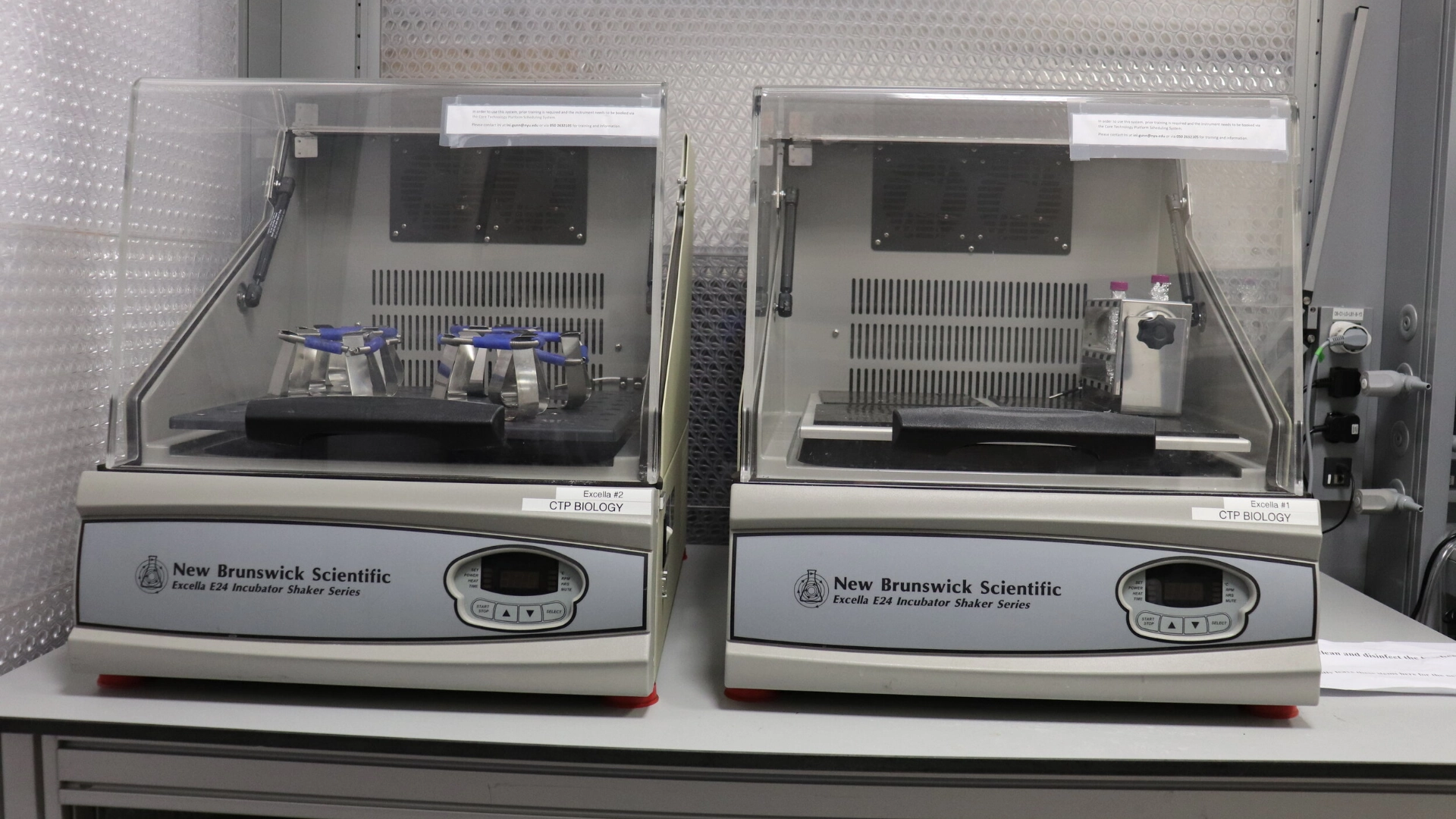
The Excella E24 Incubator Shaker is a laboratory device designed for precise temperature control and agitation of biological samples. It combines an incubator and a shaker, making it ideal for culturing cells, bacteria, yeast, and other microorganisms that require consistent environmental conditions and agitation for optimal growth.
Key Features
Temperature Control:
- Precise incubation with a broad temperature range, suitable for various applications.
- Uniform temperature distribution within the chamber.
Orbital Shaking:
- Adjustable shaking speeds for gentle to vigorous mixing.
- Orbital motion ensures consistent agitation of samples.
Capacity and Versatility:
- Accommodates a variety of flask sizes, test tubes, and microplates.
- Interchangeable platforms for different sample containers.
User-Friendly Interface:
- Digital display for easy monitoring and setting of temperature and speed.
- Programmable settings for custom protocols.
Durability and Safety:
- Built with high-quality materials for long-term use.
- Safety features like over-temperature protection.
Compact Design:
- Benchtop size ideal for laboratories with limited space.
Applications
The Excella E24 Incubator Shaker is used in a variety of scientific and industrial settings, including:
Microbial Culture Growth:
- Bacteria, yeast, and fungal cultures for research and industrial purposes.
Cell Culture:
- Mammalian and plant cell cultures requiring agitation and controlled temperatures.
Biotechnology and Pharmaceutical Research:
- Protein expression, enzyme production, and fermentation studies.
Genomics and Proteomics:
- DNA/RNA extraction protocols that require mixing and incubation.
- Protein folding and expression studies.
Educational and Research Labs:
- Teaching basic microbiology and cell biology techniques.
Industrial Applications:
- Production of bio-products like enzymes, antibiotics, and biofuels.
